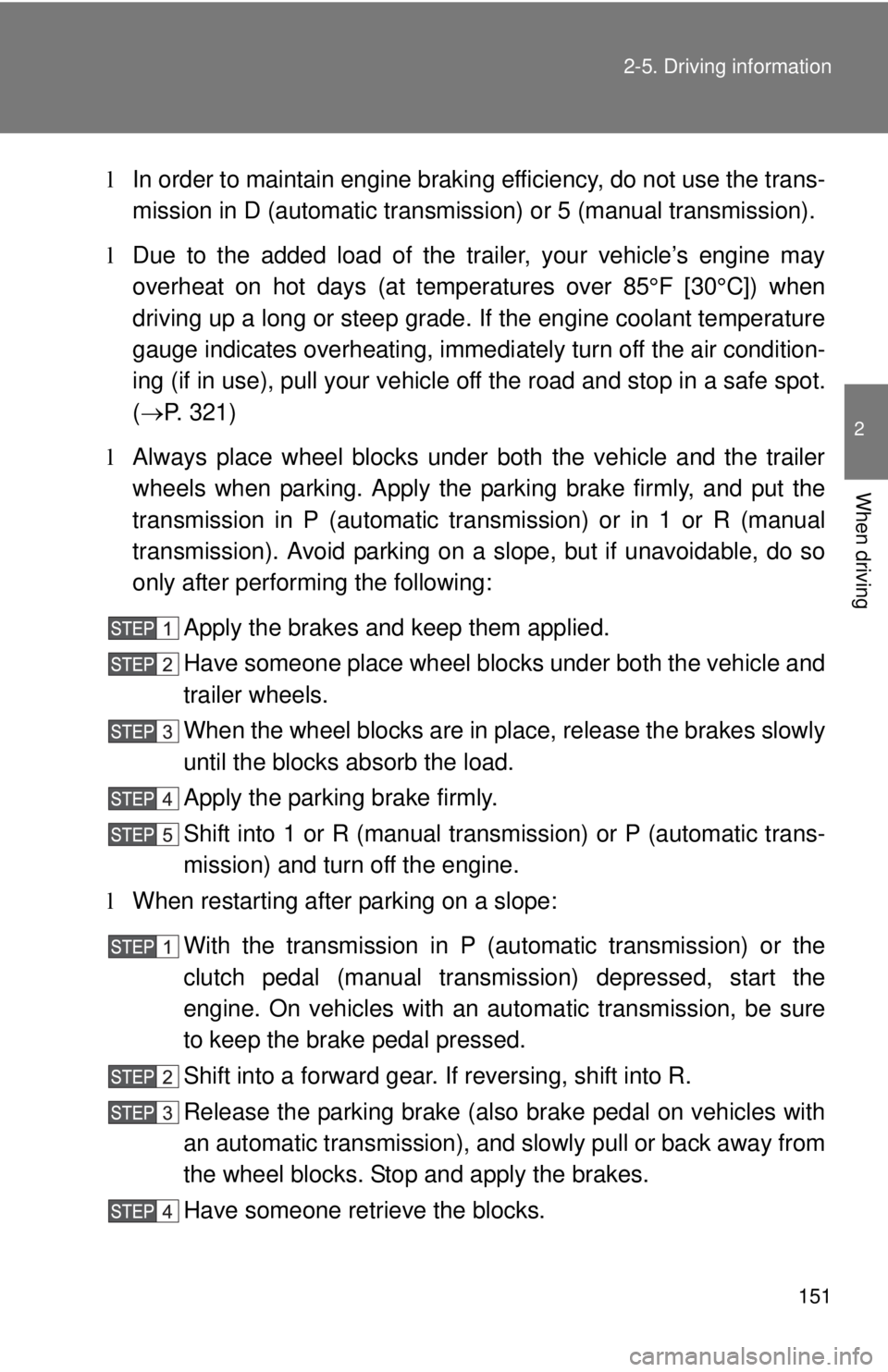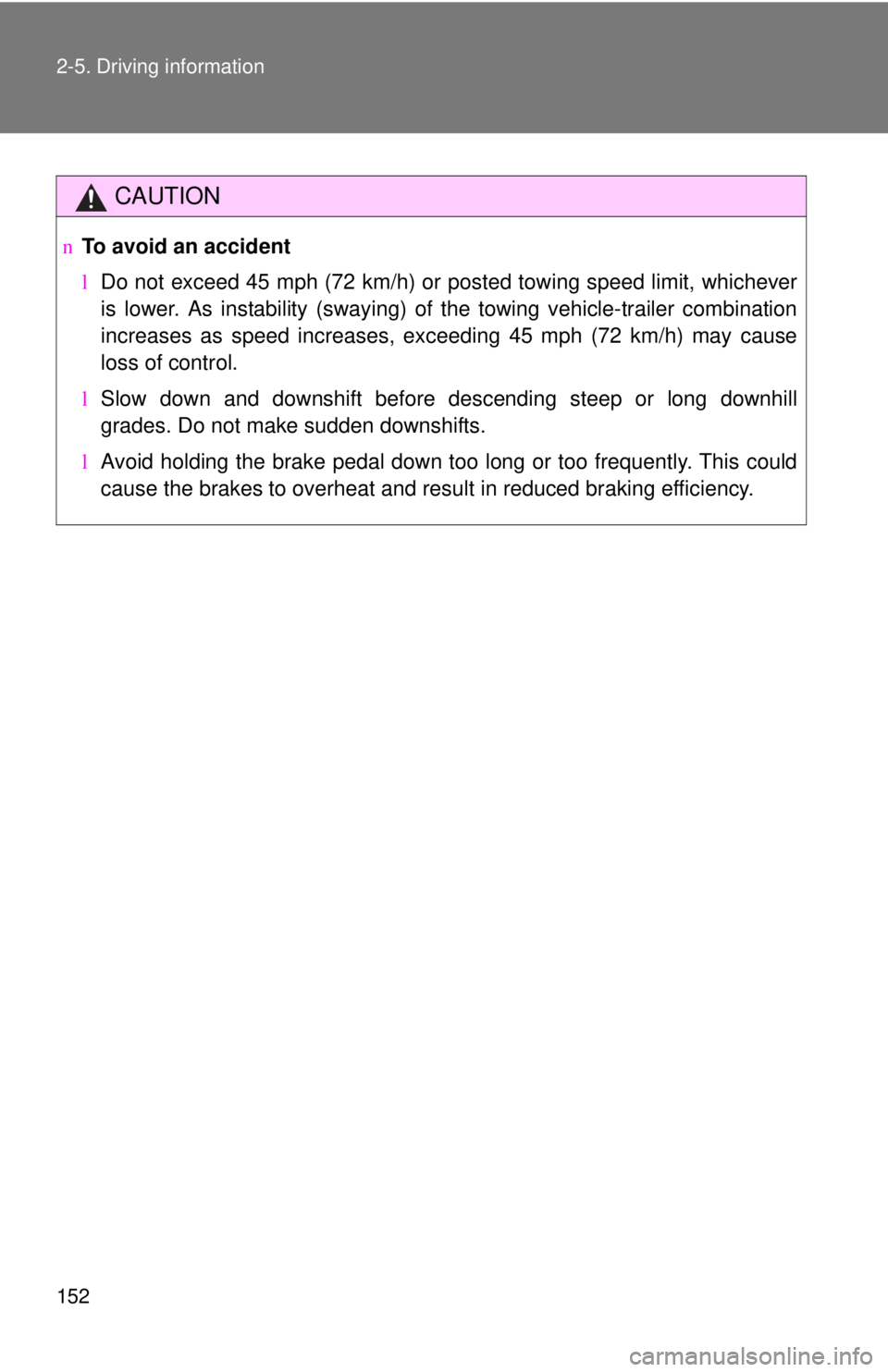2009 TOYOTA YARIS SEDAN trailer
[x] Cancel search: trailerPage 163 of 388

148 2-5. Driving information
CAUTION
nTo avoid accident or injury
lThe total trailer weight (trailer weight plus the weight of cargo) must not
exceed 700 lb. (318 kg)
l Do not exceed the trailer hitch assembly weight, gross vehicle weight,
gross axle weight and trailer tongue load capacities.
n Hitches
Trailer hitch assemblies have different weight capacities established by the
hitch manufacturer. Even though the vehicle may be rated for towing a
higher weight, the operator must never exceed the maximum weight rating
specified for the trailer hitch.
lIf you wish to install a trailer hitch, your Toyota dealer should be consulted.
l Use only a hitch that conforms to the total trailer weight requirement.
l Follow the directions supplied by the hitch manufacturer.
l Lubricate the hitch ball with a light coat of grease.
l Remove the trailer hitch whenever y ou are not towing a trailer to reduce
the possibility of additional damage caused by the hitch if your vehicle is
struck from behind.
n When towing a trailer
lNever tap into your vehicle’s hydraulic system, as this will lower the vehi-
cle’s braking effectiveness.
l Never tow a trailer without using a safety chain securely attached to both
the trailer and the vehicle. If damage occurs to the coupling unit or hitch
ball, there is danger of the trailer wandering into another lane.
Page 164 of 388

149
2-5. Driving information
2
When driving
Trailer towing tips
Your vehicle will handle differently when towing a trailer. The three
main causes of vehicle-trailer ac cidents are driver error, excessive
speed and improper trailer loading. Keep these in mind when towing.
l Before starting out, check the trailer’s light and the vehicle-trailer
connections. Recheck after driving a short distance.
l Practice turning, stopping and reve rsing with the trailer attached in
an area away from traffic until you become accustomed to the feel
of the vehicle.
NOTICE
n When installing a trailer hitch
Use only the position recommended by your Toyota dealer. Do not install the
trailer hitch on the bumper; this may cause body damage.
n Brakes
Toyota recommends trailers with brakes that conform to any applicable fed-
eral and state/provincial regulations.
n Safety chain
A safety chain must always be used between the towing vehicle and the
trailer. Leave sufficient slack in the chain for turns. The chain should cross
under the trailer tongue to prevent the tongue from dropping to the ground in
the case that it becomes damaged or separated. For the correct safety chain
installation procedure, ask your Toyota dealer.
n Do not directly splice trailer lights
Directly splicing may damage your vehicle’s electrical system and cause a
malfunction.
Page 165 of 388

150 2-5. Driving information
lReversing with a trailer attached is difficult and requires practice.
Grip the bottom of the steering wheel and move your hand to the
left to move the trailer to the left. Move your hand to the right to
move the trailer to the right. (This is generally opposite to reversing
without a trailer attached.) Avoid sharp or prolonged turning. Have
someone guide you when reversing to reduce the risk of an acci-
dent.
l As stopping distance is increased when towing a trailer, vehicle-to-
vehicle distance should be increased. For each 10 mph (16 km/h)
of speed, allow at least o ne vehicle and trailer length.
l Avoid sudden braking as you may skid, resulting in jackknifing and
loss of control. This is especiall y true on wet or slippery surfaces.
l Avoid jerky starts or sudden acceleration. Vehicles with a manual
transmission, prevent excessive cl utch slippage by keeping engine
rpm low and not racing the engine. Always start out in first gear.
l Avoid jerky steering and sharp turns, and slow down before mak-
ing a turn.
l Note that when making a turn, th e trailer wheels will be closer than
the vehicle wheels to the inside of the turn. Compensate by making
a larger than normal turning radius.
l Crosswinds and rough roads will adversely affect handling of your
vehicle and trailer, causing sway . Periodically check the rear to
prepare for being passed by large trucks or buses, which may
cause your vehicle and trailer to sway. If swaying occurs, firmly grip
the steering wheel, reduce speed immediately but gradually, and
steer straight ahead. Never increase speed. If you make no
extreme correction with the stee ring or brakes, your vehicle and
trailer will stabilize.
l Take care when passing other v ehicles. Passing requires consider-
able distance. After passing a vehi cle, do not forget the length of
your trailer, and be sure you hav e plenty of room before changing
lanes.
Page 166 of 388

151
2-5. Driving information
2
When driving
l
In order to maintain engine braking efficiency, do not use the trans-
mission in D (automatic transmiss ion) or 5 (manual transmission).
l Due to the added load of the trailer, your vehicle’s engine may
overheat on hot days (at temperatures over 85°F [30°C]) when
driving up a long or steep grade. If the engine coolant temperature
gauge indicates overheating, immedi ately turn off the air condition-
ing (if in use), pull your vehicle off the road and stop in a safe spot.
( → P. 321)
l Always place wheel blocks under both the vehicle and the trailer
wheels when parking. Apply the parking brake firmly, and put the
transmission in P (automatic transmission) or in 1 or R (manual
transmission). Avoid parking on a slope, but if unavoidable, do so
only after performing the following:
Apply the brakes and keep them applied.
Have someone place wheel blocks under both the vehicle and
trailer wheels.
When the wheel blocks are in pl ace, release the brakes slowly
until the blocks absorb the load.
Apply the parking brake firmly.
Shift into 1 or R (manual transmission) or P (automatic trans-
mission) and turn off the engine.
l When restarting after parking on a slope:
With the transmission in P (automatic transmission) or the
clutch pedal (manual transmission) depressed, start the
engine. On vehicles with an au tomatic transmission, be sure
to keep the brake pedal pressed.
Shift into a forward gear. If reversing, shift into R.
Release the parking brake (also brake pedal on vehicles with
an automatic transmission), and slowly pull or back away from
the wheel blocks. Stop and apply the brakes.
Have someone retrieve the blocks.
Page 167 of 388

152 2-5. Driving information
CAUTION
nTo avoid an accident
lDo not exceed 45 mph (72 km/h) or posted towing speed limit, whichever
is lower. As instability (swaying) of the towing vehicle-trailer combination
increases as speed increases, exceeding 45 mph (72 km/h) may cause
loss of control.
l Slow down and downshift before descending steep or long downhill
grades. Do not make sudden downshifts.
l Avoid holding the brake pedal down too long or too frequently. This could
cause the brakes to overheat and result in reduced braking efficiency.
Page 339 of 388

328
6-1. Specifications
Maintenance data (fuel, oil level, etc.)
Dimensions and weight
*1: P175/65R14 tires
*2: P185/60R15 tires
*3: Canada only
Overall length169.3 in. (4300 mm)
Overall width66.5 in. (1690 mm)
Overall height 57.5 in. (1460 mm)
Wheelbase100.4 in. (2550 mm)
Tread
Front58.3 in. (1480 mm)*1
57.9 in. (1470 mm)*2
Rear57.9 in. (1470 mm)*1
57.5 in. (1460 mm)*2
Vehicle capacity weight
(Occupants + luggage) 845 lb. (383 kg)
Towing capacity*3
(Trailer weight + cargo)700 lb. (318 kg)
Page 377 of 388

369
Alphabetical index
Power door lock switch........... 26
Power window switch ............. 52
Turn signal lights .................. 113
Window lock switch ................ 53
Wiper and washer ................ 129
Tachometer .............................. 117
Tail lights Indicator................................ 126
Replacing light bulbs ............ 270
Switch ................................... 126
Wattage ................................ 337
Theft deterrent system
Alarm ...................................... 60
Engine immobilizer system..... 58
Theft prevention labels ........... 62
Theft prevention labels ............. 62
Tire inflation pressure ............ 248
Tire information Glossary ............................... 348
Size ...................................... 345
Tire identification number ..... 344
Uniform tire quality grading ............................... 346
Tires
Chains .................................. 141
Checking .............................. 242
If you have a flat tire ............. 303
Identification number ............ 341
Inflation pressure .......... 248, 336
Inflation pressure sensor ...... 243
Information ........................... 341
Replacing ..................... 242, 303
Rotating tires ........................ 242
Size ...................................... 336
Snow tires............................. 141
Spare tire .............................. 303
Tire pressure warningsystem........................ 242, 296
Warning light ........................ 296
Tools......................................... 303
Total load capacity .................. 140 Towing
Dinghy towing................153, 154
Emergency towing.................283
Trailer towing.................144, 145
Trip meter .................................120
Trunk ...........................................31
Trunk light Wattage .................................337
Turn signal lights Indicator ................................113
Lever .....................................113
Replacing light bulbs .............270
Switch....................................113
Wattage .................................337
Vanity mirrors...........................201
Vehicle identification number ...................................329
Warning buzzers Brake system ........................293
Seat belt reminder .................296
Warning lights ABS .......................................294
Airbag system .......................294
Anti-lock brake system ..........294
Brake system ........................293
Charging system .... ...............294
Driver’s seat belt ...................296
Electric power steering system ................................294
Electronic engine control system ................................294
Engine oil replacement..........296
EPS system...........................294
Front passenger occupant classification system ...........294
Front passenger’s seat belt ...296
High engine coolant temperature ........................294
Low brake fluid ......................293
Low engine oil pressure ........294
T
V
W
Page 386 of 388

1
2
3
4
5
6
7
3
2-4. Using other driving systems ........................... 132
Cruise control ...................... 132
Driving assist systems ........ 135
2-5. Driving information ........... 137 Cargo and luggage ............. 137
Vehicle load limits ............... 140
Winter driving tips ............... 141
Trailer towing (except Canada) ............... 144
Trailer towing (Canada) ...... 145
Dinghy towing (vehicles with an automatic
transmission) .................... 153
Dinghy towing (vehicles with a
manual transmission)........ 154
3-1. Using the air conditioning system and defogger...... 158
Air conditioning system ....... 158
Rear window and outside rear view mirror
defoggers .......................... 164
3-2. Using the audio system.... 166 Audio system types ............. 166
Using the radio .................... 169
Using the CD player ............ 175
Playing back MP3 and WMA discs ........................ 181
Optimal use of the audio system .............................. 188
Using the AUX adapter ....... 190 3-3. Using the interior lights ... 192
Interior lights list ................. 192
• Interior light ...................... 193
• Personal lights.................. 193
3-4. Using the storage features ........................... 194
List of storage features ....... 194
• Glove box ......................... 194
• Console box ..................... 195
• Cup holders (front) ........... 196
• Cup holders (rear) ............ 197
• Bottle holders ................... 198
• Auxiliary box ..................... 198
3-5. Other interior features ..... 200 Sun visors........................... 200
Vanity mirrors ..................... 201
Clock .................................. 202
Portable ashtray ................. 203
Cigarette lighter .................. 204
Power outlet ....................... 205
Armrest ............................... 206
Floor mat ............................ 207
4-1. Maintenance and care ...... 210 Cleaning and protecting the vehicle exterior ........... 210
Cleaning and protecting the vehicle interior ............ 212
4-2. Maintenance...................... 215 Maintenance requirements .................... 215
General maintenance ......... 217
3Interior features
4Maintenance and care